小学三年级英语语法全
- 格式:doc
- 大小:128.50 KB
- 文档页数:12
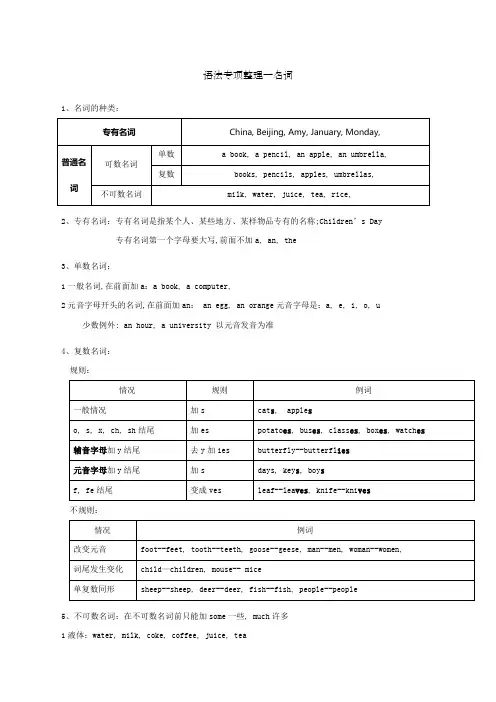
语法专项整理一名词1、名词的种类:2、专有名词:专有名词是指某个人、某些地方、某样物品专有的名称;Children’s Day专有名词第一个字母要大写,前面不加a, an, the3、单数名词:1一般名词,在前面加a:a book, a computer,2元音字母开头的名词,在前面加an: an egg, an orange元音字母是:a, e, i, o, u 少数例外: an hour, a university 以元音发音为准4、复数名词:规则:不规则:5、不可数名词:在不可数名词前只能加some一些, much许多1液体:water, milk, coke, coffee, juice, tea2气体:air, vapour3不能“个别的”存在:hair, rice, beef, meat, pork, mutton语法专项整理二代词1、人称代词2、物主代词3、指示代词:this, that, these, those如:This is my doll. That is Mary’s.Look at the those sheep. They are eating grass.语法专项整理三数词1、基数词:表示数目的多少2、序数词:表示顺序1、介词的分类2、at, on, in在表示时间时的区别:1at用于具体的时刻:at 10:05, at noon, at night,2on用于具体的一天常与星期、节日、具体的某一天连用,也表示某天上午、下午或晚上:on Monday, on New Year’s Day, on June 1st, on my birthday, on Friday morning, on the weekend,3in用于某一段时间常与上午、下午、晚上连用,常与月份、季节、年份连用:in the morning, in the afternoon, in the evening, in March, in spring, in 2007,语法专项整理六There be结构1、概念:There be结构又叫存在句,表示某地存在某物;2、There be 结构的肯定句(1)There is + 可数名词单数 + 地点:There is a book on the desk.(2)There is + 不可数名词 + 地点:There is some water in the glass(3)There are + 可数名词复数 + 地点:There are some flowers in the garden.就近原则:若句子中有几个并列的主语,be动词的形式和最近的一个主语保持一致There is a book and 2 pencils in the bag.There are many flowers and a tree in the garden.3、There be 结构的疑问句把be动词提到句子前面,若句子中有some,要变为anyIs there a book on the desk Is there any water in the glassAre there any flowers in the garden语法专项整理七现在进行时1、概念:表示说话时正在进行的动作;提示词:Now, look, listen2、构成:be动词 + 现在分词: be动词后面的动词要加ing,变成动名词;形式例句第一人称单数 + am + 现在分词I am reading a book.第三人称单数+ is + 现在分词He is doing homework. She is flying a kite.第二人称单数/各人称复数+ are + 现在分词We are cooking dinner. They are cleaning the room.3、现在分词规则例词一般情况,加ing Walk-walking, do-doing语法专项整理八一般现在时1、概念:表示现在存在着的状况,也可理解为习惯性的动作,不断重复发生的事;提示词:always, often, usually, sometimes, never, every morning, every… ~2、构成:3、动词单三形式:语法专项整理九一般将来时1、概念:表示将来要做的事,要发生的动作;提示词:tomorrow, tonight, this afternoon, this evening, this weekend, next weekend, next Monday,2、构成:1be动词 + going to + 动词原形:I am going to watch TV after dinner.He is going to buy a book this afternoon.They are going to go swimming next Sunday.情态动词cancan在英语中有一个特殊的名字,叫做情态动词,表示“能够”,“会”,“能力”后面要跟着表示动作的动词;没有时态和人称的变化;表示不能做什么的时候,后面加上not为cannot,或者缩写为can’t;问别人“能吗”要把can放在句子前面,首字母要大写,句尾别忘加上问号;Icanswing.Icandraw.—Shecancanplay.—Wecantouch.Theycanrun.—Ican’tcan’tsee.—Shecan’tcan’thearacar.三年级下册期末复习资料回答:Yes,it is. No,it isn’t.Is he / she…回答:Yes, he /she is. No, he/she isn’t.Are you …回答:Yes, I am. No, I am not.Are these/they ...回答:Yes,they are. No,they aren’t.Do you...回答:Yes, I do. No, I don’t.Does he/she/it…回答:Yes,he does. No. he doesn′t.Is there...回答:Yes,there is. No, there isn’t.Are there...回答:Yes,there are. No, there aren’t.特殊疑问句:首先确定特殊疑问词:哪里状语:什么 colour:问颜色表语:谁回答用He is... She is... They are...等:怎么样 many:多少数量 much:多少钱价格Who’s he/she回答:He’s/She’s…Who are they 回答:They are...Where is.. 回答:It’s in/on...介词短语Where are…回答:They are in/on...介词短语Where are you from 回答:I am from... / We are from...Where is he / she/ it from 回答: He /She / It is from …Where are they from 回答: They are from....What’s in / on / near/ under / beside the …回答:There is /are ...How many... 回答:There is one./There are two.2个或2个以上的数字 What is it/this/that单数回答:It’s a …….What are they/these/those复数回答:They’re …日常用语:Put...on/in介词短语... 回答: OK/All right.Draw... 回答: OK/All right.Thank you 回答: You’re welcome.Here’s ... 回答:Thank you二、名词单数变复数,一般都把s 加;特殊变化有以下:1.单数复数一个样, sheep--sheep fish- fish goldfish - goldfishChinese-Chinese Japanese -Japanese2.遇到oo 变ee : foot-feet goose- geese tooth - teeth3.有些变化就是大:mouse – mice child - children man-men woman-women4 .以s, x, sh, ch 结尾 , +es bu s-buses, bo x-boxes, bru sh-brushes,wat ch-watches5、以0 结尾有生命的o+es tomat o-tomatoes番茄例外:kangaroo- kangaroos6、以辅音字母+y结尾,改y为i+es la dy-ladies, ba by-babies stu dy-studies7.以f 或fe结尾,改f或fe为v+es kni fe- knives shel f-shelves三、have与has 的区别:have, has 都是“有”,它们的用法有讲究, 表示“某人有某物”,have, has请记住;he, she, it “有”用has, I, we , they , you 都用 have;主人单数用 has , 主人复数用 have;have 就是能力强,疑问否定don’t / do not都用它;四、have ,has 与there is , there are 的区别表示某人或某动物有: has / have I have a dog. The dog has a short tail. 表示某地方有: there is / are There is a book in the bag.五、Some与any 的区别:some用于肯定句中,any用于否定句和疑问句中;如:I have some books. I don’t have any books. Do you have any books六.a 与an 的区别一般来讲,元音字母即a, e , i, o , u 开头的单词用an如: an apple an ear an American girl an Australian stamp an old man 七. There be 句型即 there is / there are意思:表示某地方有某人或某物原则:就近原则 There be 句型中的be 动词用is 还是用are 由最靠近它的第一个名词是单数还是复数决定;如: There is a book and some pens on the desk.There are some pens and a book on the desk.八.不可数名词: juice chalk tissue 不可数名词没有复数形式There is some chalk.There is some juice.There is some tissue.九.’s所有格:表示:某人或某动物的the girl’s name 那个女孩的名字the teacher’s desk 讲台the headmaster’s office 校长的办公室the children’s toys 儿孩子们的玩具the teachers’ room 教师办公室当名词的复数形式是以“s”结尾时,直接加’十. be 动词 : is are am 表示“是”I 用am , you 用are , is 连着he,she ,it ;单数名词用is ,复数名词全用are ;如: I am …. You are…. We are…. They are…. . He is….. She is….. It is….The girl is …. The boys are…. Ben is…. Janet and Ben are…。
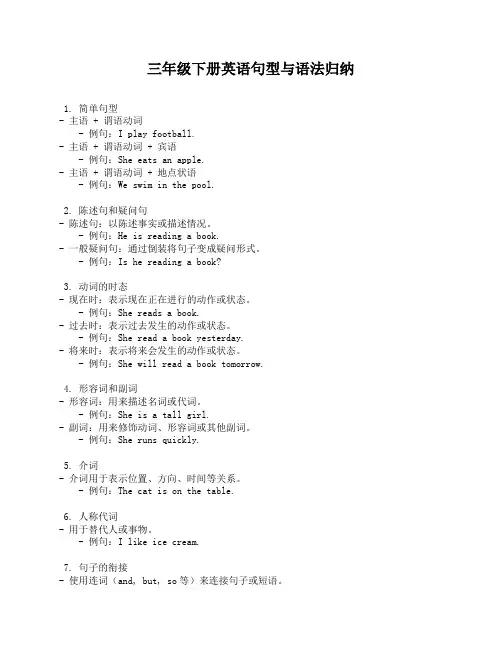
三年级下册英语句型与语法归纳1. 简单句型- 主语 + 谓语动词- 例句:I play football.- 主语 + 谓语动词 + 宾语- 例句:She eats an apple.- 主语 + 谓语动词 + 地点状语- 例句:We swim in the pool.2. 陈述句和疑问句- 陈述句:以陈述事实或描述情况。
- 例句:He is reading a book.- 一般疑问句:通过倒装将句子变成疑问形式。
- 例句:Is he reading a book?3. 动词的时态- 现在时:表示现在正在进行的动作或状态。
- 例句:She reads a book.- 过去时:表示过去发生的动作或状态。
- 例句:She read a book yesterday.- 将来时:表示将来会发生的动作或状态。
- 例句:She will read a book tomorrow.4. 形容词和副词- 形容词:用来描述名词或代词。
- 例句:She is a tall girl.- 副词:用来修饰动词、形容词或其他副词。
- 例句:She runs quickly.5. 介词- 介词用于表示位置、方向、时间等关系。
- 例句:The cat is on the table.6. 人称代词- 用于替代人或事物。
- 例句:I like ice cream.7. 句子的衔接- 使用连词(and, but, so等)来连接句子或短语。
- 例句:I like apples and bananas.8. 祈使句- 用于表达请求、命令等。
- 例句:Close the door, please.9. 疑问词- 用于提问,如who, what, where, when, why, how等。
- 例句:Where is the nearest supermarket?10. 句型转换- 可以通过改变句子结构或词序来改变句子的意思。
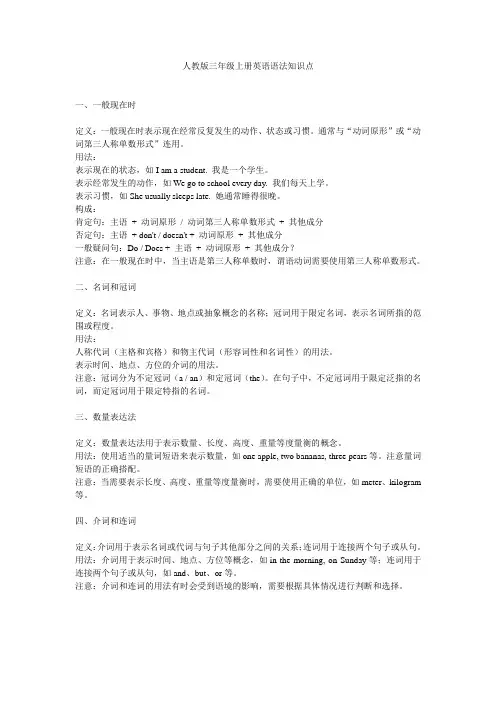
人教版三年级上册英语语法知识点一、一般现在时定义:一般现在时表示现在经常反复发生的动作、状态或习惯。
通常与“动词原形”或“动词第三人称单数形式”连用。
用法:表示现在的状态,如I am a student. 我是一个学生。
表示经常发生的动作,如We go to school every day. 我们每天上学。
表示习惯,如She usually sleeps late. 她通常睡得很晚。
构成:肯定句:主语+ 动词原形/ 动词第三人称单数形式+ 其他成分否定句:主语+ don't / doesn't + 动词原形+ 其他成分一般疑问句:Do / Does + 主语+ 动词原形+ 其他成分?注意:在一般现在时中,当主语是第三人称单数时,谓语动词需要使用第三人称单数形式。
二、名词和冠词定义:名词表示人、事物、地点或抽象概念的名称;冠词用于限定名词,表示名词所指的范围或程度。
用法:人称代词(主格和宾格)和物主代词(形容词性和名词性)的用法。
表示时间、地点、方位的介词的用法。
注意:冠词分为不定冠词(a / an)和定冠词(the)。
在句子中,不定冠词用于限定泛指的名词,而定冠词用于限定特指的名词。
三、数量表达法定义:数量表达法用于表示数量、长度、高度、重量等度量衡的概念。
用法:使用适当的量词短语来表示数量,如one apple, two bananas, three pears等。
注意量词短语的正确搭配。
注意:当需要表示长度、高度、重量等度量衡时,需要使用正确的单位,如meter、kilogram 等。
四、介词和连词定义:介词用于表示名词或代词与句子其他部分之间的关系;连词用于连接两个句子或从句。
用法:介词用于表示时间、地点、方位等概念,如in the morning, on Sunday等;连词用于连接两个句子或从句,如and、but、or等。
注意:介词和连词的用法有时会受到语境的影响,需要根据具体情况进行判断和选择。

三年级下册英语句型与语法归纳在三年级下册的英语学习中,学生将继续掌握更多的句型和语法知识。
这些知识将帮助他们构建正确的句子,表达自己的意思。
下面是对三年级下册英语句型与语法的详细介绍。
一、句型:1. 主语 + be动词 + 形容词这个句型用来描述人或物的状态或特征。
例如:- He is tall.(他高)- The flower is beautiful.(花很漂亮)2. 主语 + 动词 + 宾语这个句型用来表示主语做了某个动作。
例如:- She reads a book.(她读书)- We eat dinner.(我们吃晚饭)3. 主语 + 动词 + 地点副词这个句型用来表示主语在某个地方做某个动作。
例如:- He swims in the pool.(他在游泳池里游泳)- They play soccer on the field.(他们在 ** 上踢足球)4. 主语 + 动词 + 时间副词这个句型用来表示主语在某个时间做某个动作。
例如:- I brush my teeth in the morning.(我早上刷牙)- They watch TV in the evening.(他们晚上看电视)5. 主语 + 动词 + 助动词 + 不定式这个句型用来表示主语将要做某个动作。
例如:- She is going to study for the test.(她准备要为考试学习)- We are going to visit the zoo.(我们打算要去动物园)6. 主语 + can + 动词这个句型用来表示主语具有某种能力。
例如:- He can swim.(他会游泳)- They can play the piano.(他们会弹钢琴)二、语法:1. 一般现在时这是最基本的时态,用来表示经常或一直发生的事情。
句子中的动词要用原形。
例如:- She likes ice cream.(她喜欢冰淇淋)- We go to school every day.(我们每天去上学)2. 现在进行时这个时态用来表示现在正在发生的事情。
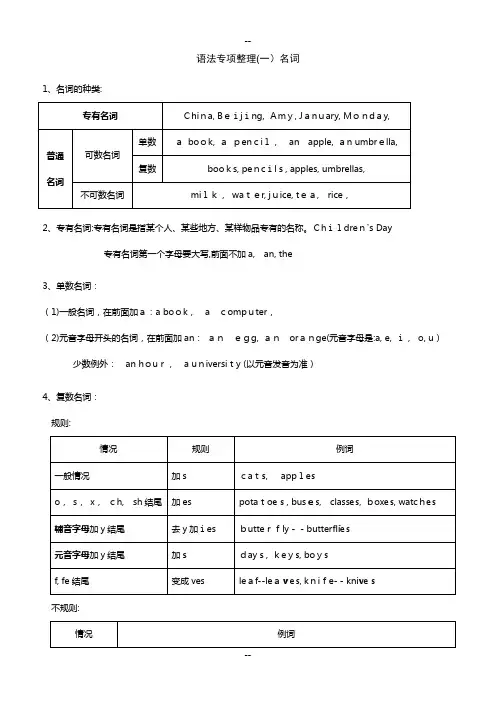
语法专项整理(一)名词1、名词的种类:2、专有名词:专有名词是指某个人、某些地方、某样物品专有的名称。
Children’s Day专有名词第一个字母要大写,前面不加a, an, the3、单数名词:(1)一般名词,在前面加a:a book, a computer,(2)元音字母开头的名词,在前面加an:anegg, anorange(元音字母是:a, e, i,o, u)少数例外:an hour, a university (以元音发音为准)4、复数名词:规则:不规则:5、不可数名词:在不可数名词前只能加some(一些), much(许多)(1)液体:water, milk, coke, coffee, juice, tea(2)气体:air,vapour(3)不能“个别的”存在:hair,rice,beef, meat,pork,mutton语法专项整理(二)代词1、人称代词2、物主代词3、指示代词:this, that,these, those如:This is my doll. That isMary’s.Look at the thosesheep.Theyare eating grass.语法专项整理(三)数词1、基数词:表示数目的多少2、序数词:表示顺序1、介词的分类2、at, on, in在表示时间时的区别:(1)at用于具体的时刻:at 10:05, atnoon,at night,(2)on用于具体的一天(常与星期、节日、具体的某一天连用,也表示某天上午、下午或晚上):on Monday, on NewYear’s Day, on June 1st, on my birthday, onFridaymorning, on the weekend,(3)in用于某一段时间(常与上午、下午、晚上连用,常与月份、季节、年份连用):in the morning, in the afternoon, in the evening, in March, in spring, in 2007,语法专项整理(六)Therebe结构1、概念:There be结构又叫存在句,表示某地存在某物。
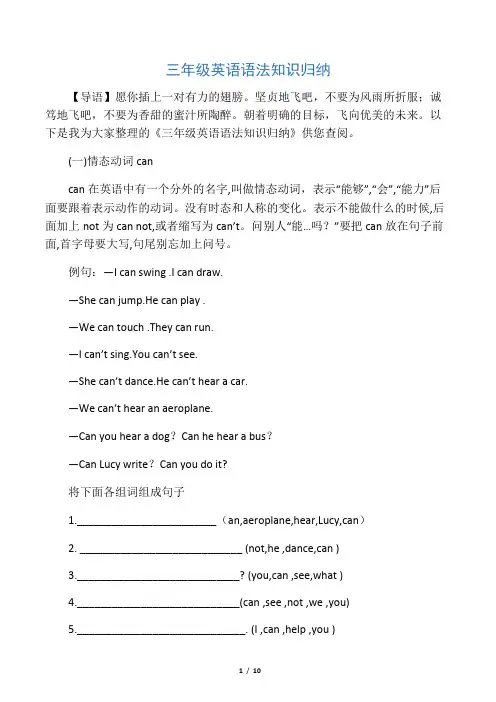
三年级英语语法知识归纳【导语】愿你插上一对有力的翅膀。
坚贞地飞吧,不要为风雨所折服;诚笃地飞吧,不要为香甜的蜜汁所陶醉。
朝着明确的目标,飞向优美的未来。
以下是我为大家整理的《三年级英语语法知识归纳》供您查阅。
(一)情态动词cancan在英语中有一个分外的名字,叫做情态动词,表示“能够”,“会”,“能力”后面要跟着表示动作的动词。
没有时态和人称的变化。
表示不能做什么的时候,后面加上not为can not,或者缩写为can’t。
问别人“能…吗?”要把can放在句子前面,首字母要大写,句尾别忘加上问号。
例句:―I can swing .I can draw.―She can jump.He can play .―We can touch .They can run.―I can’t sing.You can’t see.―She can’t dance.He can’t hear a car.―We can’t hear an aeroplane.―Can you hear a dog?Can he hear a bus?―Can Lucy write?Can you do it?将下面各组词组成句子1.________________________(an,aeroplane,hear,Lucy,can)2. ____________________________ (not,he ,dance,can )3.____________________________? (you,can ,see,what )4.____________________________(can ,see ,not ,we ,you)5._____________________________. (I ,can ,help ,you )6._____________________________? (I,can ,do,what)7._____________________________? (you ,can ,hear me)8._____________________________? (you ,can ,dance)答案:1. Lucy can hear an aeroplane.2. He can not /can’t dance.3. What can you see?4. We can not /can’t see you5. I can help you.6. What can I do?7. Can you hear me? 8. Can you dance?(二)人称代词所属格.人称代词表注意:主格作主语,其中she指带代国家,it可指代天气时间等。
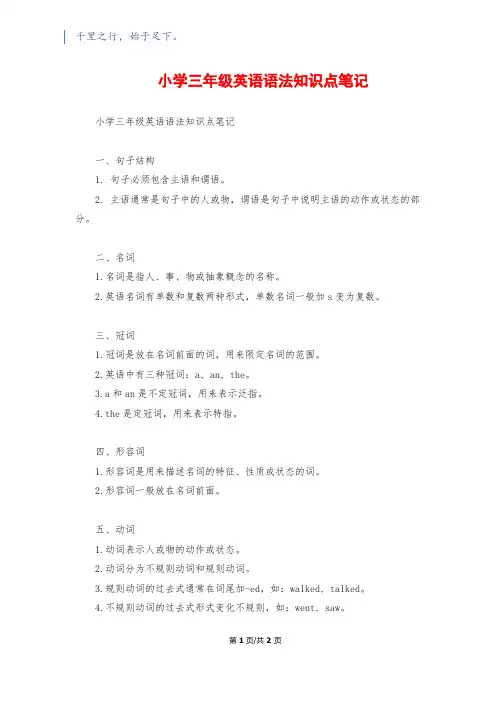
千里之行,始于足下。
小学三年级英语语法知识点笔记小学三年级英语语法知识点笔记一、句子结构1. 句子必须包含主语和谓语。
2. 主语通常是句子中的人或物,谓语是句子中说明主语的动作或状态的部分。
二、名词1.名词是指人、事、物或抽象概念的名称。
2.英语名词有单数和复数两种形式,单数名词一般加s变为复数。
三、冠词1.冠词是放在名词前面的词,用来限定名词的范围。
2.英语中有三种冠词:a, an, the。
3.a和an是不定冠词,用来表示泛指。
4.the是定冠词,用来表示特指。
四、形容词1.形容词是用来描述名词的特征、性质或状态的词。
2.形容词一般放在名词前面。
五、动词1.动词表示人或物的动作或状态。
2.动词分为不规则动词和规则动词。
3.规则动词的过去式通常在词尾加-ed,如:walked, talked。
4.不规则动词的过去式形式变化不规则,如:went, saw。
第1页/共2页锲而不舍,金石可镂。
六、副词1.副词用来描述动词、形容词、副词或全句的词。
2.副词一般放在动词或形容词的后面。
3.副词有一般副词和比较级副词两种形式。
七、介词1.介词是连接名词或代词与其他词组或句子的词。
2.一些常见的介词有:in, on, at, with, of等。
八、代词1.代词是用来代替名词的词。
2.代词可以用来指示人或物,表示人称和所有格。
九、连词1.连词用来连接单词、短语或句子。
2.常见的连词有:and, but, or, so等。
十、形容词性物主代词1.形容词性物主代词用来表示所有关系。
2.形容词性物主代词有my, your, his, her, its, our, their等。
十一、不定代词1.不定代词是用来指代不具体的人或物的词。
2.常见的不定代词有: some, any, every, no等。
以上就是小学三年级英语语法的一些基本知识点的笔记,希望对你有所帮助。
如果你还有其他问题,可以继续提问。
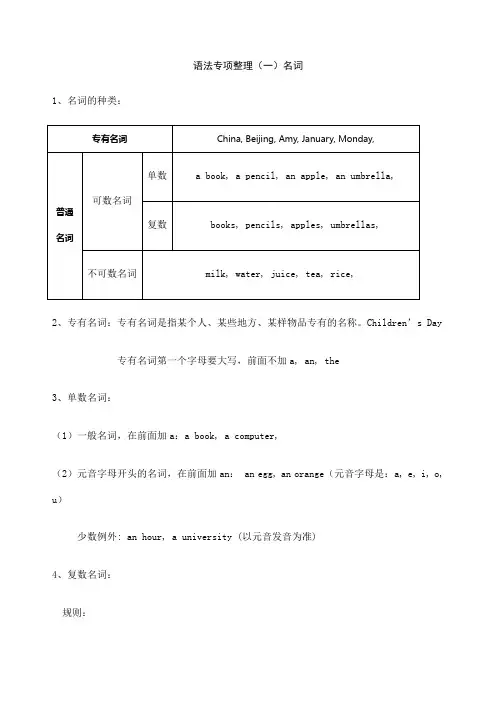
语法专项整理(一)名词1、名词的种类:2、专有名词:专有名词是指某个人、某些地方、某样物品专有的名称。
Children’s Day专有名词第一个字母要大写,前面不加a, an, the3、单数名词:(1)一般名词,在前面加a:a book, a computer,(2)元音字母开头的名词,在前面加an: an egg, an orange(元音字母是:a, e, i, o, u)少数例外: an hour, a university (以元音发音为准)4、复数名词:规则:不规则:5、不可数名词:在不可数名词前只能加some(一些), much(许多)(1)液体:water, milk, coke, coffee, juice, tea(2)气体:air, vapour(3)不能“个别的”存在:hair, rice, beef, meat, pork, mutton语法专项整理(二)代词1、人称代词2、物主代词3、指示代词:this, that, these, those如:This is my doll. That is Mary’s.Look at the those sheep. They are eating grass.语法专项整理(三)数词1、基数词:表示数目的多少2、序数词:表示顺序语法专项整理(五)介词1、介词的分类2、at, on, in在表示时间时的区别:(1)at用于具体的时刻:at 10:05, at noon, at night,(2)on用于具体的一天(常与星期、节日、具体的某一天连用,也表示某天上午、下午或晚上):on Monday, on New Year’s Day, on June 1st, on my birthday, on Friday morning, on the weekend,(3)in用于某一段时间(常与上午、下午、晚上连用,常与月份、季节、年份连用):in the morning, in the afternoon, in the evening, in March, in spring, in 2007,语法专项整理(六)There be结构1、概念:There be结构又叫存在句,表示某地存在某物。
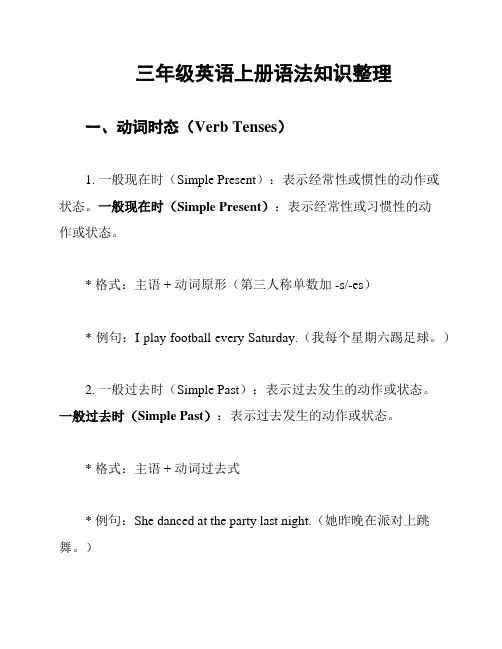
三年级英语上册语法知识整理一、动词时态(Verb Tenses)1. 一般现在时(Simple Present):表示经常性或惯性的动作或状态。
一般现在时(Simple Present):表示经常性或习惯性的动作或状态。
* 格式:主语 + 动词原形(第三人称单数加 -s/-es)* 例句:I play football every Saturday.(我每个星期六踢足球。
)2. 一般过去时(Simple Past):表示过去发生的动作或状态。
一般过去时(Simple Past):表示过去发生的动作或状态。
* 格式:主语 + 动词过去式* 例句:She danced at the party last night.(她昨晚在派对上跳舞。
)3. 一般将来时(Simple Future):表示将来要发生的动作或状态。
一般将来时(Simple Future):表示将来要发生的动作或状态。
* 格式:主语 + will + 动词原形* 例句:We will visit our grandparents next week.(我们下周要去看望我们的祖父母。
)二、名词(Nouns)1. 可数名词(Countable Nouns):表示可以数有几个的名词。
可数名词(Countable Nouns):表示可以数有几个的名词。
* 例句:There are three apples on the table.(桌子上有三个苹果。
)2. 不可数名词(Uncountable Nouns):表示不能数的名词。
不可数名词(Uncountable Nouns):表示不能数的名词。
* 例句:I need some water.(我需要一些水。
)三、形容词(Adjectives)* 一般比较级的形式:原级 + -er* 一般最高级的形式:原级 + -est* 例句:This book is longer than that book.(这本书比那本书长。
![[全]小学三年级英语语法知识点考点总结](https://uimg.taocdn.com/c1dc970a6f1aff00bfd51ea5.webp)
小学三年级英语语法知识点考点总结(一)情态动词cancan 在英语中有一个特殊的名字,叫做情态动词,表示“能够”, “会”, “能力”后面要跟着表示动作的动词。
没有时态和人称的变化。
表示不能做什么的时候,后面加上not为can not,或者缩写为can’t。
问别人“能…吗?”要把can 放在句子前面,首字母要大写,句尾别忘加上问号。
例句:—I can swing .I can draw.—She can jump.He can play .—We can touch .They can run.—I can’t sing.You can’t see.—She can’t dance.He can’t hear a car.—We can’t hear an aeroplane.—Can you hear a dog?Can he hear a bus?—Can Lucy write?Can you do it?(二)人称代词所属格. 人称代词表注意:主格作主语,其中she指代国家,it可指代天气时间等。
宾格作宾语,介词宾语,表语。
动词后面用人称宾格形容词性物主代词作定语。
名词性物主代词作主语,宾语,介词宾语,表语书信yours…表示---- 的,这样的词我们也学习很多了,你能想出来吗?记住这个小口诀就很容易了:我的my,你的your,他的his、她的her. //它的是its; 我们的our; 你们的是your他们(它们,她们)的是their这些人称代词形式称为人称代词所属格,也叫形容词性物主代词。
通常用在名词前面表示所属关系。
另外,表示某人的还可以用名词或人名+ ’s 来表示。
如: my kite; your book; his pen; her coat; its tail; our class;their teachers; my brother’s; book; the cat’s ears; Mary’s mother。
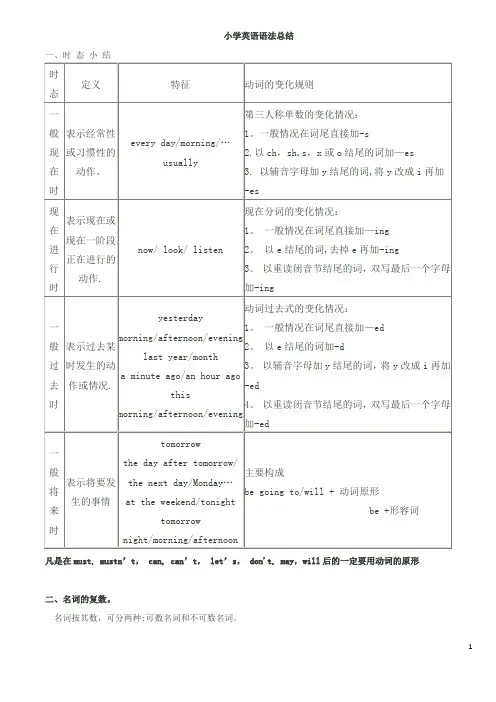
小学英语语法总结一、时态小结凡是在must, mustn’t,can, can’t,let’s, don't, may,will后的一定要用动词的原形二、名词的复数。
名词按其数,可分两种:可数名词和不可数名词。
可数名词的复数变化规则:1。
一般情况下,直接在词尾加-s,如:girl—girls, book-books, pen-pens2。
以s,x,sh,ch结尾的词,在词后加-es, 如:class—classes, box—boxes, match—matches,3. 以辅音字母+y结尾的,变y 为i 再加-es,如:city—cities, family—families, country— countries 4。
以f或fe结尾的,变f或fe为v再加-es,如:knife—knives, wife—wives, life—lives,5。
以o 结尾的加—es或—s, 如: radio-radios, tomato—tomatoes, potato—potatoes, zoo—zoos,photo-photos,6。
man—men, woman-women, foot—feet, child-children,三、形容词的比较级、最高级。
形容词有比较级与最高级之分,单音节词的变化规则:1。
一般情况下,直接在词尾加-er或—est, 如:small-smaller—smallest, short—shorter—shortest2. 以e结尾的,加-er或-est,如:large—larger—largest, nice—nicer—nicest。
3.以辅音字母+y结尾的,变y 为i 再加—er或-est, 如:busy—busier—busiest, heavy—heavier-heaviest。
4。
以重读闭音节,一个辅音字母结尾的,双写该字母,再加—er或—est,如:big—bigger—biggest,thin-thinner-thinnest。
英语语法三年级英语语法(汇编11篇)英语语法三年级英语语法第1篇表达自己是否喜欢某物的句型-I (don't)like...(1)课文应用:I like grapes.我喜欢葡萄。
Sorry,I don't like grapes.抱歉,我不喜欢葡萄。
(2)句型结构I (don't) like+某物(bananas, grapes, apples…).(3)重点解析表达自己喜欢某物的句型为“I like+某物”。
like意为“喜欢”,它跟在“主人”I的后面,表示“主人”的喜好。
但当“主人”不喜欢某物时,don't就会站在like的前面来帮忙了,它与like -起来表达“主人”不喜欢某物。
don't是do not的缩写形式,帮助构成否定句。
如果like 后面接的表示事物的名词是可数名词,要用其复数形式。
巧用don't来否定在一般现在时的句子中,含有实义动词的肯定句在变为否定句时,需要don't或doesn't来帮忙。
如果主语是第三人称单数,要在实义动词前加doesn't,后面接动词原形。
例如:She like apples.她不喜欢苹果。
如果主语不是第三人称单数,只需在实义动词前加don't。
例如:They don't go to school.他们不去上学。
英语语法三年级英语语法第2篇一般疑问句及特殊疑问句句子基本是:简单陈述句,由简单陈述句转变成肯定句,否定句,疑问句。
疑问句是用来提出问题。
英语中有四种疑问句: 一般疑问句、特殊疑问句、选择疑问句和反意疑问句。
我们现在已经接触到了前两种疑问句。
后两种疑问句以后我们还会学到.一般疑问句:英语中要用 yes和no 来回答的疑问句叫一般疑问句。
如:1)Is it hot ?Yes, it is .\No, it isn' -- be动词引导2)Is it a car ?Yes, it is .\No, it isn't . -- be动词引导3)Is this your ruler ?Yes, it is .\No, it isn't . -- be动词引导4)Do you like bananas ? -- 含实义动词Yes, I like \ No, I don't like5)Can Ming hear a drill ? --含情态动词Yes , Ming can hear a \No,Ming can't hear a陈述句(肯定句,否定句,一般疑问句)的转变规律:肯定句:否定句:一般疑问句及肯否定回答1) 主语+be动词+…. 1) 主语+be动词+not+…. 1)be动词+主语+…? Yes, 主语+be动词./No, 主语+be动词+I am a I am not a Are you a teacher?--Yes, I No, I amMy mother is My mother is not /isn't Is your mother thin? --Yes, she No, she isn'They are They are not/aren't Are they insects?they No, they aren'2) 主语+情态动词can+… 2) 主语+情态动词can+ not+…. 2)情态动词can+主语+…?Yes, 主语+情态动词can/No,主语+情态动词can+ notHe can He can not/can't Can he jump?--Yes,he No, he can'3) 主语+动词+…. 3) 主语+助动词do/does+not 3) 助动词do/does+主语+…. 动词原形 +….动词原形?Yes, 主语+助动词No, 主语+助动词do/does+He likes to eat He doesn't like to eat Does he like to eat apples?Yes,he No,he doesn'We like to eat We don't like to eat Do you like to eat apples? Yes,we /No,we don'二. 祈使句:表示请求、命令、建议或劝告等的句子叫祈使句,主语you常省略。
三年级英语主谓宾语法一、主谓宾基本概念。
1. 主语(Subject)- 在句子中表示动作的执行者或被描述的对象。
在三年级英语中,主语常常是名词或者代词。
- 例如:I(我)、he(他)、she(她)、it(它)、we(我们)、they(他们)这些代词可以作主语;cat(猫)、dog(狗)、book(书)等名词也能作主语。
如“I like apples.”(我喜欢苹果)中,“I”就是主语。
2. 谓语(Predicate)- 谓语一般是动词,表示主语的动作或状态。
- 在简单的句子中,像“run(跑)、jump(跳)、eat(吃)、drink(喝)”等都是谓语动词。
例如“He runs fast.”(他跑得快),“runs”就是谓语。
3. 宾语(Object)- 宾语是动作的对象,跟在谓语动词后面。
- 同样可以是名词或者代词。
在“She likes dogs.”(她喜欢狗)中,“dogs”就是宾语。
二、主谓宾在简单句中的结构及例句(人教版三年级)1. 肯定句结构:主语 + 谓语 + 宾语。
- 例句:- I have a pen.(我有一支笔。
)其中“I”是主语,“have”是谓语,“a pen”是宾语。
- He eats an apple.(他吃一个苹果。
)“He”为主语,“eats”为谓语,“an apple”为宾语。
2. 一般疑问句结构:助动词(Do/Does)+ 主语 + 谓语(原形)+ 宾语?- 对于以第一人称(I、we)、第二人称(you)以及复数主语(they)为主语的句子,用“Do”。
- 例如:Do you like bananas?(你喜欢香蕉吗?)“you”是主语,“like”是谓语(这里因为前面有助动词“Do”,所以用原形“like”),“bananas”是宾语。
- 对于第三人称单数(he、she、it)为主语的句子,用“Does”。
- 例如:Does she read a book?(她读书吗?)“she”是主语,“read”是谓语(因为前面有“Does”,所以用原形),“a book”是宾语。
小学三年级英语语法复习资料 一、复数 1、直接加“s” table—tables book—books cat---cats goat----goats piano---pianos TV---TVs egg—eggs hat—hats 2、辅音+ y 结尾,把y 改ies baby---babies family—families 3、特殊变化 ox—oxen 二、同义词 paint ( 涂油漆)---draw (绘画) 三、is、 am、are 的用法 I 用am, You 用are, is 用于he, she, it和单数,名词复数全用are, are, are,要想提问be 题前,否定not在be后面 。 练习题: 用is、am 、are 填空 1、Yeah, she______ a student. 2、I ______ Jenny. He______ Peter. 3、How old ______you? I’m ten. 4、 _______ this a cat? 5、You _____ my friend. 6、What _____ this ? It’s a cat. 7、My sister_______ a teacher. 8、How old ______ your brother? 四、用英语填空 1、This _____a box. 2、She ______ draw a balloon. 3、He’s ______unhappy boy. 4、_______ you paint? Yes, I can. 5、This is ______ exercise book. 6、What’s _______name? ______name’s Ms. Black. 7、_______that boy? He’s my brother. 8、What _____ is the banana? It’s _______. 9、A dog _____swim. But a cat _____swim. 10、______a bird fiy? Yes , ____ _____. 11、________ do you ________? I like_____ ______.(雪糕) 12、________this? ______ a pencil. 13、I _____like bread. 五、句子:(试卷常错的) 1、Let’s count the candles. 让我们一起数数蜡烛。 OK. 好的。 2、You’re a good boy. 你是一个好男孩。 Thank you. / Thanks. 谢谢。 3、Who’s that boy? 那男孩是谁? He’s my friend. 他是我的朋友。 4、Oh, it’s a banana. 噢,它是一个香蕉。 5、What’s this? 这是什么? A pencil. 一只铅笔。 或: It’s a pencil. 它是一只铅笔。 6、What color is the banana? 这个苹果是什么颜色? It’s yellow. 它是黄色。
小学三年级英语语法全第1讲字母1、英语中共有26个字母。
Aa,Ee,Ii,Oo,Uu是元音字母,Yy是半元音字母,其余是辅音字母。
英语单词就是由这26个字母组合而成的。
Aa和Ii可以独立成词,分别表示“一个(张……)”和“我”的意思,Ii翻译成“我”时要大写。
2、英语字母可以分为印刷体和书写体。
在书、报、杂志上见到的一般都是印刷体。
在四线三格上书写时应注意书写位置,可以记住以下口诀:大写字母不顶格,小写字母占满格。
书写时还要注意字母的笔顺。
3、英语句子的第一个单词的首字母要大写。
单词与单词之间在书写时必须保持适当的距离,一般以空出一个小写字母的宽度为宜。
句子的末尾要有标点符号。
4、英语中的句号是一个实心圆点(.),省略号是三个居下的实心圆点(…),英语中没有顿号和书名号,顿号用逗号替代,书名用斜体字表示。
5、英语缩写词PRC中华人民共和国UN 联合国WHO 世界卫生组织NBA美国职业篮球联赛KFC 肯德基IT 信息技术EQ 情商CCTV 中国中央电视台kg 千克a.m. 上午USA 美国HK 香港WTO 世界贸易组织CBA 中国男子篮球联赛ATM 自动柜员机ID 身份证CPU 中央处理器BBC 英国广播公司cm 厘米p.m. 下午UK 英国SOS 国际求救信号UFO 不明飞行物VIP 贵宾EMS邮政特快专递IQ 智商RMB 人民币VOA 美国之音No. 号码6第2讲 语音1、音素:语音的最小单位。
2、元音:发音时气流不受阻碍。
元音分为单元音和双元音两类。
单元音发音时唇形和舌位不变;双元音发音时由一个元音向另一个 元音滑动,唇形和舌位有一个变化过程,且前重后轻,前长后短。
3、辅音:发音时气流受到阻碍。
辅音分为清辅音和浊辅音两类。
清辅音发音时声带不振动;浊辅音发音时声带振动。
4、音标:用来记录音素的符号。
为了避免与字母混淆,音标被放在斜括号/ /内。
5、英语中的一个字母或字母组合在不同的单词中发音可能是不一样的,而相同的 发音对应的字母或字母组合也可能不完全相同。
6、开音节:以元音字母结尾或以一个元音字母加一个辅音字母再加不发音的e 结尾(r 除外)的音节。
元音字母在开音节中读长音,即该字母的名称音。
闭音节:以一个或几个辅音字母(r 除外)结尾。
元音字母在闭音节中读短音。
第3讲名词名词是指表示人和事物名称的词,可以分为专有名词和普通名词两大类。
1、专有名词:特定的人、地方、机构等专有的名称。
第一个字母通常要大写。
e.g. Jim Green,New York,Bank of China,Peking University星期、月份、节日、学科、报刊名也是专有名词。
e.g. Monday,May,Christmas,Spring Festival,Maths,China Daily2、普通名词:表示一类人或物或抽象概念的名称。
普通名词又可以分为四类:个体名词——表示某类人或东西中的个体,如:student , desk集体名词——表示若干个体组成的集合体,如:class , family物质名词——表示无法分为个体的物质名称,如:water , rice , sand,hair抽象名词——表示情感,状态,品质等抽象名称,如:love ,carelessness个体名词和集体名词多数可以用数目来计算,称为可数名词,有单、复数形式;物质名词和抽象名词通常无法用数目计算,称为不可数名词,一般只有一种形式。
注意:①集体名词被看作一个整体时,表达单数概念。
e.g. His family was well known in the town.他家在镇里是名门望族。
②集体名词被看作若干个体的集合时,表达复数概念。
e.g. His family are waiting for him.她的家人正在等他。
③集体名词表达多个集体时,也有复数形式。
e.g. Our village is made up of 300 families. 我们村有300户人家。
3、可数名词复数形式的构成规则:①一般名词在末尾直接加s,清辅音后读/ s /,浊辅音和元音后读/ z /e.g. book-books,bag-bags,cat-cats,bed-beds②以s、x、sh、ch结尾,加es,读/ IZ /e.g. bus-buses,box-boxes,brush-brushes,watch-watches③以辅音字母+y结尾,变y为i,再加es,读/ z /e.g. baby-babies,library-libraries,factory-factories④以f或fe结尾,变f或fe为v,再加es,读/ vz /e.g. thief-thieves,knife-knives⑤以o结尾,表示无生命的物体时加s, 表示有生命的物体时,加es,都读/ z /e.g. photo-photos,piano-pianos,radio-radios,zoo-zoospotato-potatoes,tomato-tomatoes,mango-mangoes,hero-heroes⑥不规则变化e.g. man-men child-children foot-feetfish-fish woman-women mouse-mice tooth-teethsheep-sheeppoliceman-policemenox-oxengoose-geesedeer-deer▲fish表示鱼的数量时,单复数同形;表示鱼的种类时,复数为fishes.e.g. My cat had two fish for lunch.You can see a lot of different fishes in the lake.4、不可数名词一般只有原形,没有复数形式,但是可以借助量词表示一定的数量。
如果表达两个或两个以上的概念时,量词需要用复数形式,不可数名词不变。
e.g. a bottle of water ,a cup of coffee,two glasses of milk ,five bags of rice▲这种形式用于可数名词时,量词和可数名词都要用复数。
e.g. ten baskets of eggs5、既可用作可数,又可用作不可数的名词:不可数glass 玻璃paper 纸iron 铁wood 木头beauty 美room 空间可数a glass 一只玻璃杯a paper 一份报纸、论文、文件a iron 一个熨斗a wood 一片森林a beauty 一个美人a room 一个房间6、名词所有格①在英语中,有些名词可以加’s来表示所有关系,带这种词尾的名词形式称为该名词的所有格。
大多数表示有生命的东西。
e.g. Tom’s book②如果复数名词末尾已有s,就直接加’。
e.g. the teachers’ office③如果一些物品为两者共有,只需在后一个名词后加’s ;如果为各自所有,则需在每个名词后加’s。
e.g. Lucy and Lily’s bedroom.(Lucy 和Lily共用一个卧室)Lucy’s and Lily’s bedrooms.(Lucy 和Lily分别拥有各自的卧室)④表示无生命的物体的名词所有格,一般与of短语连用。
e.g. a map of the world ,a photo of my family⑤双重所有格:把of所有格和’s所有格结合在一起表示所有关系。
e.g. a friend of my father’s第4讲冠词冠词一般用在名词的前面,对名词起限定作用,不能离开名词单独存在。
1、不定冠词a,an用在单数可数名词前面,泛指一类人或物中的任何一个。
①a用于辅音音素开头的名词之前。
e.g. a bed,a computer,a “U”②an用于元音音素开头的名词之前。
e.g. an egg,an umbrella,an hour2、定冠词the用在单数或复数可数名词前,也可用在不可数名词前。
①表示特指的人或物前。
e.g. The man with a flower in his hand is Jack.②指说话人双方都知道的人或物前。
e.g. Lily, close the door, please.③在上文提到过,第二次又提到的人或物前。
e.g. There is a man under the tree. The man is called James.④表示世界上独一无二的事物前。
e.g. The sun is bigger than the moon.⑤用在序数词前面。
e.g. It is the first day of the new term.⑥用在乐器名称前。
e.g. He often plays the violin at weekends.⑦用在形容词最高级前。
e.g. Spring is the best season in a year.⑧用在由普通名词构成的专有名词前。
e.g. I went to the Great Wall last week.⑨用在国家名称的缩写前。
e.g. He is from the UK.3、零冠词:名词前不用冠词的情况。
在季节、月份、星期、节假日、三餐、球类或棋类运动前,通常不用冠词。
e.g. have breakfast ,play basketball,play chess第5讲代词①主格一般用在句子开头做主语,通常用在动词前。
e.g. I am a student. They are cleaning the classroom.②宾格可以用来表示动作行为的对象,一般用在动词和介词后面。
e.g. Ask her, please. Listen to me carefully.①形容词性物主代词后面一般要带上名词。
如:my watch, his cousin, our school②名词性物主代词本身就可以看作是名词,故其后不能再加名词,可单独使用。
e.g. —Is that your bike?—No. Mine is blue.3、不定代词:没有明确指定代替某个(些)人或物的词叫不定代词。
(1)some和any都表示“一些”,既可以修饰可数名词,也可以修饰不可数名词。
①some多用在肯定句中,any多用在否定句和疑问句中。
e.g. There are some flowers in the garden. (肯定句)There isn’t any milk in the fridge. (否定句)Do you have any hobbies? (疑问句)②在表示邀请和希望对方给予肯定回答的疑问句中也要用some。